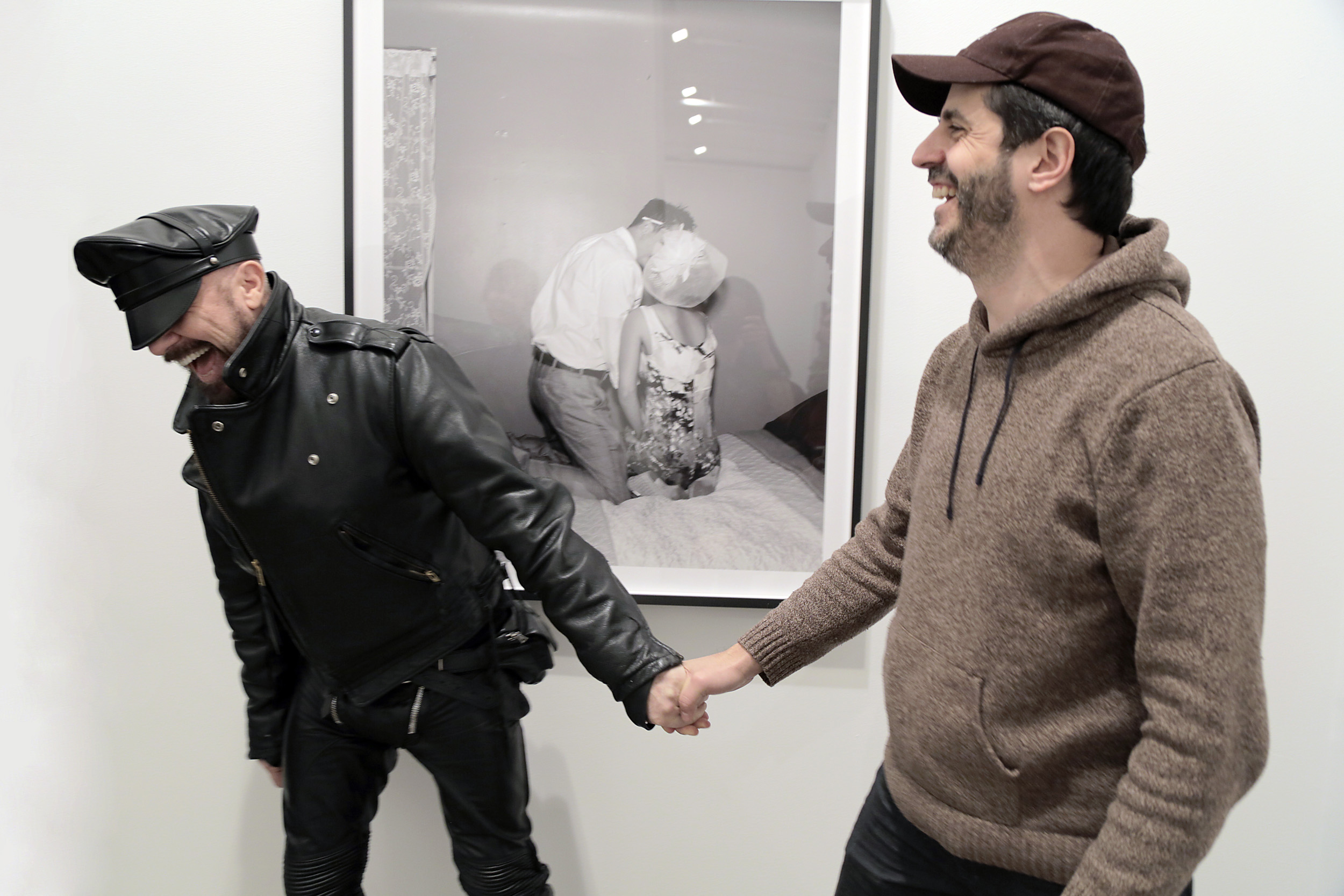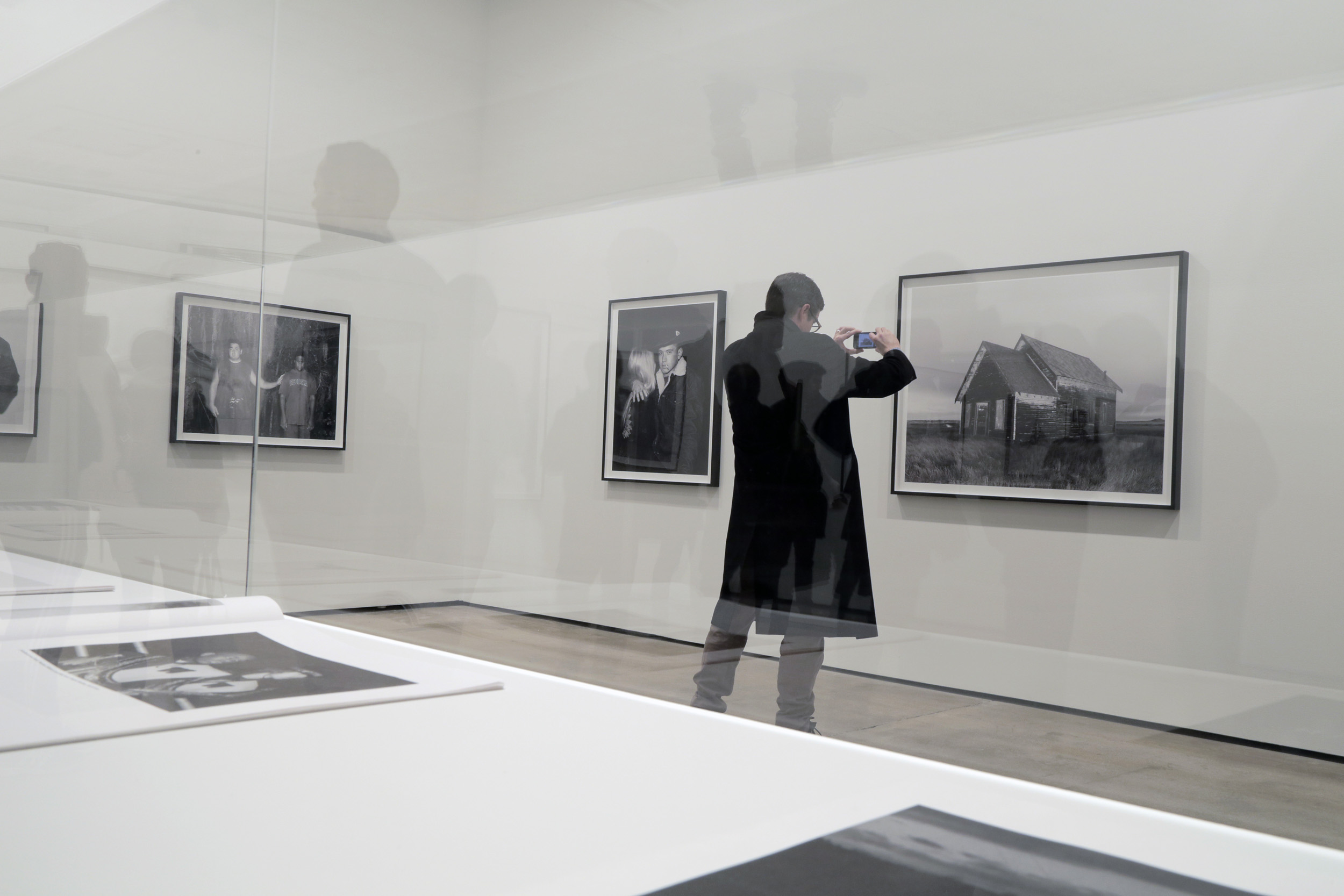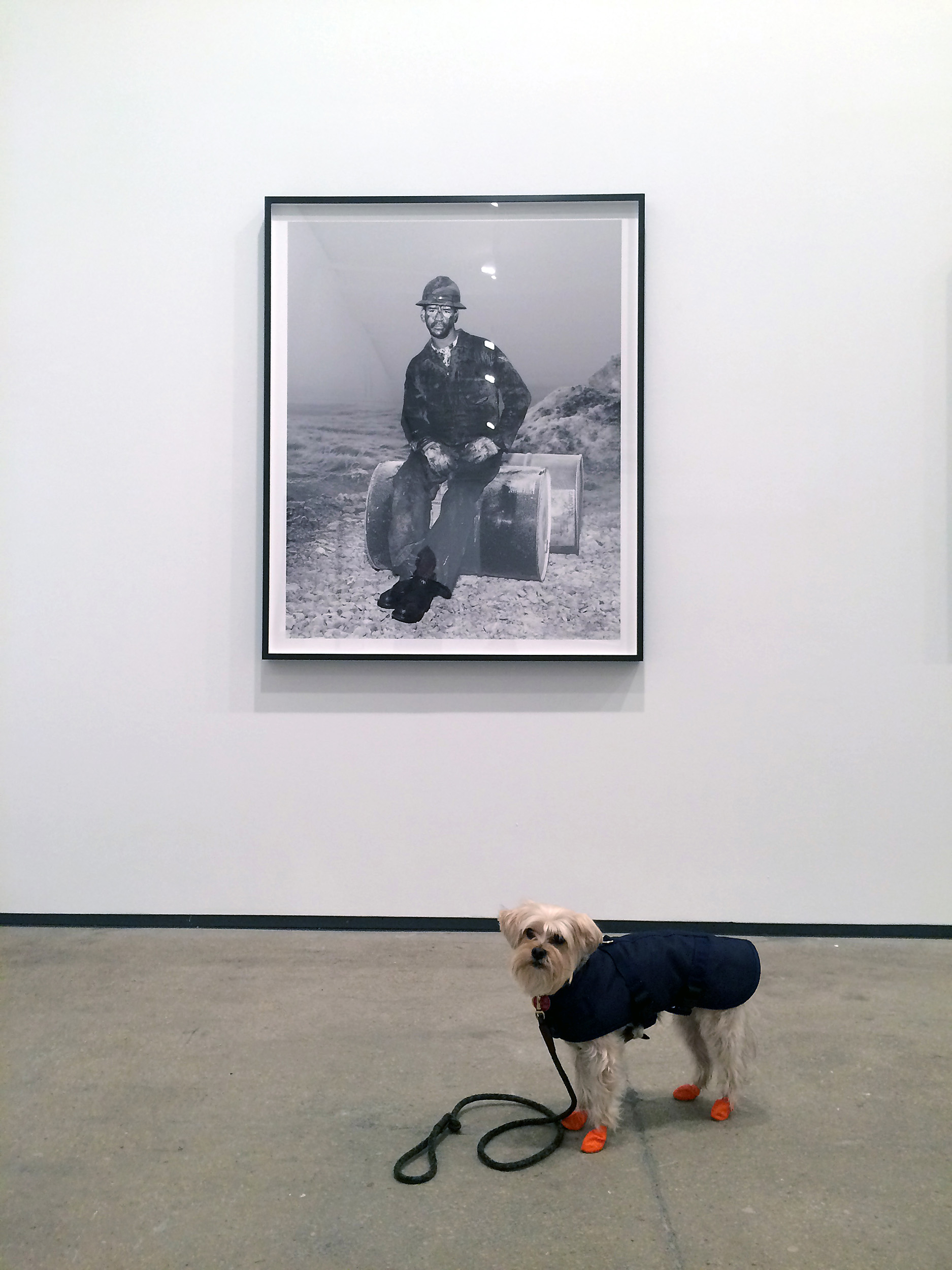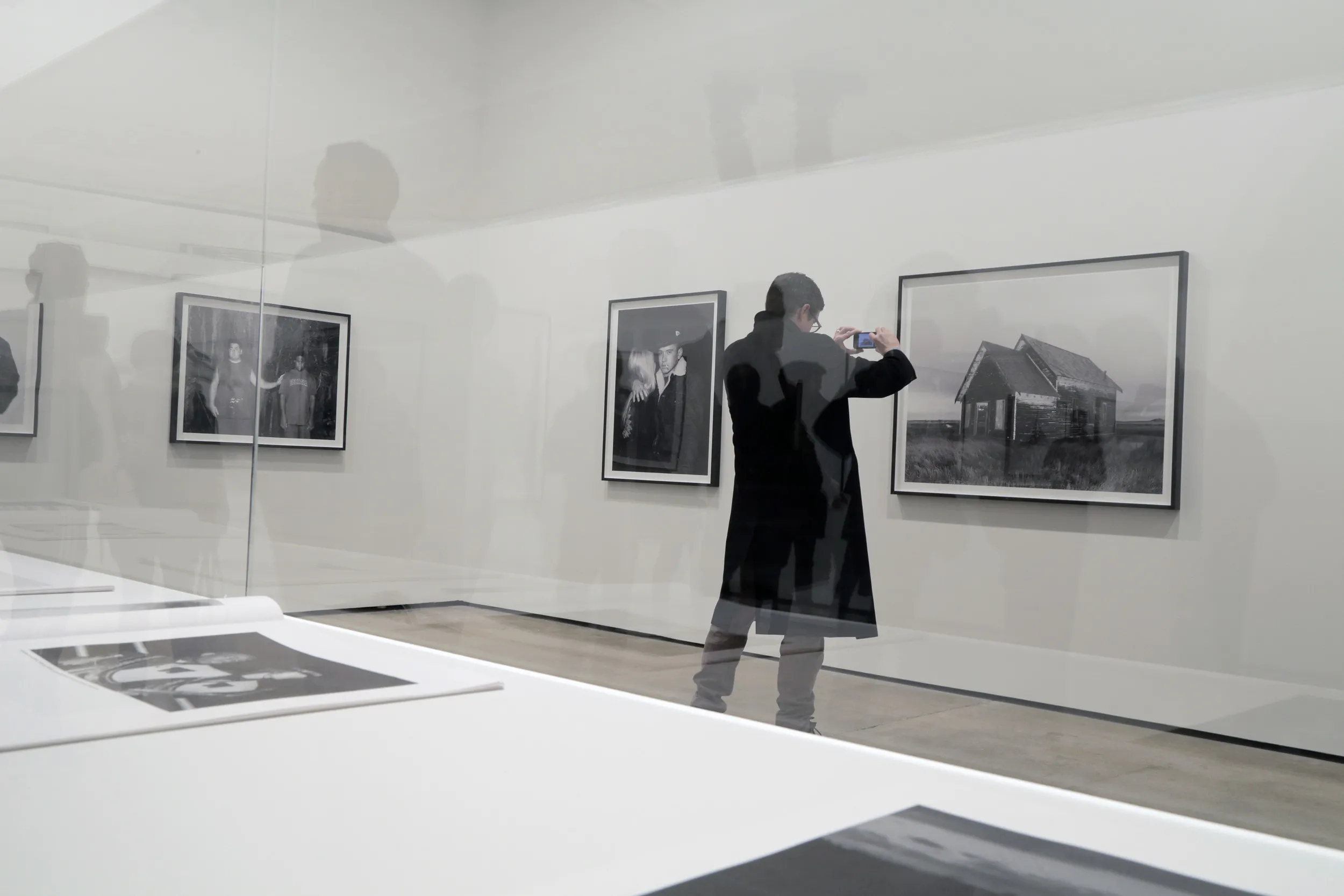
Joanna Lehan, professor: This show came out of the Dispatches project, which was included in our last ICP Triennial. We had a whole wall of books that reflected the self-publishing phenomenon, and you were such an important part of that. Is there anything you would like to tell us about the show?
Alec Soth: The way it started is complicated. Preceding all of this was Magnum Photo’s involvement with Postcards From America. The first one we did was a road trip from San Antonio to Oakland. I was the organizer of that particular trip and I invited writer Ginger Strand to join us. That, in many ways, started the ball rolling on collaborating with a writer. And then it came to be that I, on a whim, invited my friend and writer Brad Zellar, to do an imaginary photo/newspaper assignment with me. We went out and started doing a number of these locally, in Minnesota, and it took on a life of its own. Then Brad and I went to Ohio, where I was doing a talk and, kind of in connection with Magnum, we did the first LBM Dispatch. There were all these mini strands coming together. It wasn’t like "I will publish in a newspaper and then it will be this." It was continually evolving, which I think is maybe a good approach from a student perspective—that it’s not all planned out. It was about half way through doing the Dispatches that I knew (and had discussed with Brad) that I needed to have this other life—the work that was outside of the text. Brad and I had planned on doing a novel sized book/reader that would go in the literary world, but I also wanted an art book that was purely about the pictures rather than the stories, where the stories are stripped away. In this book I wanted to include a combination of pictures from the Magnum projects as well as from my editorial work. So about 80 percent of the work is from a mishmash of various things, but it all has something to do with community life in America and loneliness. One of the reasons it's called Songbook is that it’s not an essay on something, it’s more lyrical.
JL: It's an interesting time I think in history to focus on the idea of community and isolation.
AS: Yes, it is especially so because of smart phone culture, but I think it’s always been the case, particularly in America, that there’s this celebration of individualism and isolation. It's all part of being in the world in this little glass bubble. And I think photography is the medium of being in the world of not being in the world. And I kind of love that relationship.
JL: How difficult was it to think about the ways in which you were working in the tradition of "Americana"?
AS: That’s something that has been in my work from the get-go: that relationship and the connection to the American photo tradition. I think of photography as being a language, and it has different dialects, and I speak a dialect and I use it. I was definitely referencing Americana, both in subject matter and in approach. I have the belief that Americana still exists. Because that’s the thing, these places are still out there, these people are still out there, and that’s something I'm less jaded about; it's still a rich world to be explored.
JL: Each one of your photographs is really startling and fresh and manages to skirt any kind of cliché.
AS: My feeling about cliché is that I like riding up right to the edge of it. I did this project in Niagara Falls—and I think Niagara Falls is the ultimate cliché. But I wanted to show it and do it because you can get away with it if you counter balance it with a different image. Like a musical analogy, feeling is connected to cliché as we have an emotional response to things that it’s always bumping up against. But you don't want to manipulate people. When you're watching a movie, you don’t want the music to swell to force you to have a feeling that's clichéd. It's often very basic human stuff that affects you. Like this picture that’s at a blind camp in Georgia and it’s an incredibly touching picture. I think emotionally it's right on the breast of that kind of cliché. On my mind was the really blatant racism I witnessed in Georgia—I didn't want to see it, because I didn’t want that cliché of Georgia, but the fact is I did see it. But then to go to a blind camp and see black and white touching each other, it was like, wow!
JL: And literally not seeing color.
AS: And literally not seeing color! That's like a dumb metaphor but it was true. So that’s the thing about cliché. Clichés are clichés for a reason.

Theresa Ortolani: So, you stripped away the text for Songbook. I heard Brad speak about your collaborations, and the relationship between image and text at the MoMA PS1 symposium. What are your thoughts regarding the image-text relationship, and the role of photography as language?
AS: Brad has a very sophisticated understanding of photography and the way the text works with the images; he’s great about not stepping on them with text and hopefully my pictures wouldn't step on his text. And I love that Little Brown Mushroom has generally been a place to experiment with that balance. But I also love pictures on their own and their mysteries being wide open. This book was about that. Songbook is open-ended lyricisms where you can just bring whatever you bring to the pictures. In a lot of ways, I think I'm having my cake and eating it too, and you can do that with photography in some ways because it can work on different platforms. It can be in The New York Times Magazine where it's a story about oil, but then it can do the Dispatches and become more open-ended but still have a narrative component, and then here it can just be kind of wide open. It's one of the upsides of photography, especially when there are so many downsides and limitations to being a photographer. In terms of narrative, filmmaking can be such a powerful medium and I’m really envious of it—it's the cultural medium of our time. It has an incredible power that photography doesn't have. It's similar to the narrative possibilities of the novel. So, emotionally this is called Songbook, but it doesn't do that, it doesn’t do what music does. And in this day and age of fragmentations photography can be frustrating in that sense; everyone is a photographer.
TO: Do you have an inclination to make film—and combine music with narrative?
AS: The inclination comes and goes. A few years ago I started doing these experiments on the Internet in-between slideshow and photography. It kind of crashed and burned in a lot of ways though, publicly too. And that killed it for me. But every few years it swings around. The problem is, since I know photography, I have my tools, I know this; to do something entirely different is so hard.
Matthew Papa: How did you book the research in terms of finding places?
AS: It was really intense and significant research. Usually for the Dispatches we would draw up a route, and we'd work with different assistants to research every spot on the map for different events or historical topics, though half of the pictures are made on the way to those things that we researched. And that's just dumb luck, but you kind of make luck. I can never just drive aimlessly, it never works for me; I need some sort of destination. Yeah, research is huge. Research and access. I feel there should be a photography course on access, or how to get it. It's just so hard. In this case it's really different because there's three of us. I find that's like a power number; three's a group, and you can just enter into things. You look official when there are three of you. You look like a news organization. People kind of accept that because there’s an authority to it. Where, if you're alone it can look sketchy. But you use your gender, you use your age, you use whatever you have to get access.
Katrina Sorrentino: I think of that incredible access when I think of your work. Could you talk about the intimate relationship you have with people who are on the other side of your lens, your subjects?
AS: I get that a lot and I always feel like it's a bit untrue, the intimate access. I get access but it's not always super intimate, or there's distance there. I actually like a certain kind of distance. I sometimes don’t want to hear a subject's entire story so that my experience of them is the process of photographing them. When work gets talked about there's like a little myth that builds up about it, and that's one of the myths. But I guess I get described as nice.
JL: Well, you are Midwestern.
AS: But a Midwestern thing is, it’s called "Minnesota nice." It's like this fake nice. And I definitely am not "Minnesota nice." And that feels fraudulent too. That's actually related to this work. I have a tougher, edgier side and in the sense of a novel I wanted the author's voice to be a little tougher. In fact when I did those New York Times videos I used a very tough voice, that of a very unlikable narrator. I went far in that direction, which is why I got really beat up for it. This isn't that. But it has more. I think of Weegee a lot, I love Weegee. He has this quality where he's kind of laughing at the world. With this work I thought a lot about Weegee and Robert Adams as these two characters like the good angel and the devil. Because the thing about Weegee's work is that it's joyous, whereas with Robert Adams, though I love him, it's not really joyous. It’s serene. There's huge despair there. I love that Weegee joy of celebrating the chaos of the world, and this has some of that. There's a great recording of Weegee talking—it’s this advice to young photographers where he says, "You can't be a Nice Nelly." And it's so great! I love that. And that was my approach with people, not being Nice Nelly, coming in with the flash, taking over, and not being bashful about it. Maybe it's not as respectful, but it's not mean spirited either. It's OK. There are ethical issues for sure. I'm not free of those by any means, but I've had to come to terms with that a long time ago.
TO: In regard to Weegee's advice to young photographers, do you have an opinion about MFA programs? And, if you were to teach or lecture in one, what kind of advice would you give to your students?
AS: Ah, that's interesting. I've been thinking about this a lot recently. I've been interested in education. Last semester Brad and I taught a special course in Madison. I also organized a summer camp in my studio about a year and a half ago, and it was one of the greatest things I ever did. I also teach at a Limited-Residency program in Hartford, and am a visiting artist for the graduate program at the University of South Florida. So in thinking about all these different experiences coming together what I’m working on is to be able to give advice, because I'm asked for it but I don't have it yet. But I have this strong feeling that one shouldn’t get into crazy debt unless they have a lot of money from their parents or something like that. I'm actually really terrified of that issue and advising people to go to those places. Especially since I’ve seen a number of weak programs. But there are places that are strong, such as the program in Florida. It's hard for a program that costs a lot, but one of the great things about this one is that the students go out into the world and meet different artists. They move to meet in Berlin, New York, San Francisco, and then Hartford. In contrast, having spent a semester in a classroom with students seems crazy. I think you need to be out in the world, because it's not stuff you learn sitting around a table; photography itself is learned by doing it, and then this universe is learned through making connections, meeting people, and such.
JL: Well, certainly this is what we have going for us in New York City, we can stroll out the door and bump into Alec Soth.
AS: Exactly. In Minnesota we have the Minneapolis College of Art and Design, and I love the faculty there, it's super great. But I would never tell someone: move to Minnesota, spend all this money, and you're not going to make any connections, and you're not going to really be able to see that much work.
JL: I feel so lucky that we've walked here and bumped into you! Thank you, and congratulations.
AS: Thanks so much. That's really great. It’s good karma.




